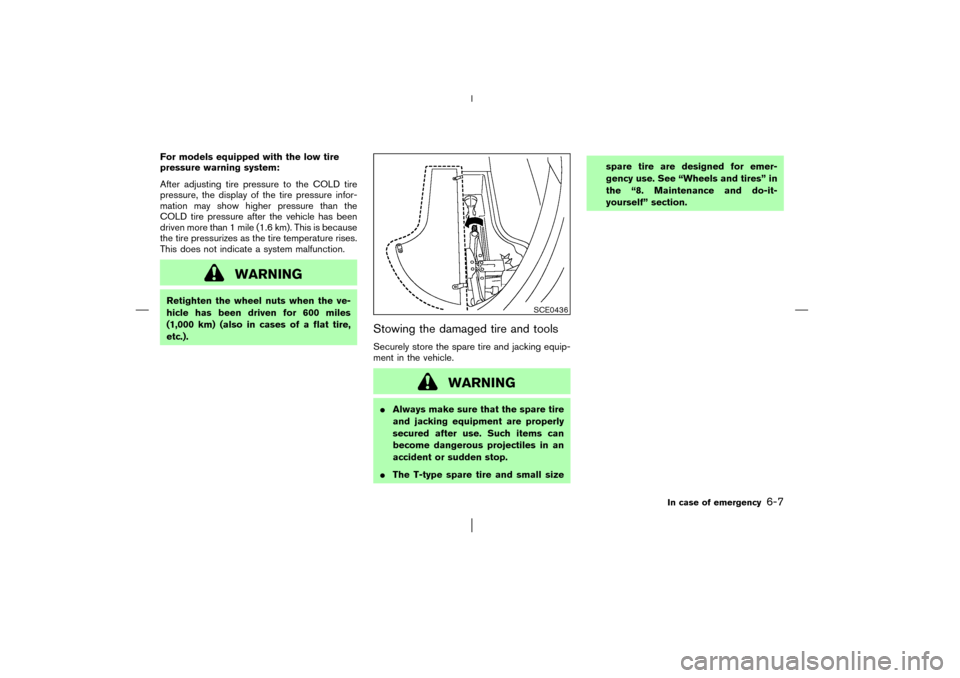Page 176 of 265
6 In case of emergencyFlat tire ...................................................................................... 6-2
Low tire pressure warning system (if so
equipped) ........................................................................... 6-2
Changing a flat tire .......................................................... 6-2
Jump starting ........................................................................... 6-8
Push starting......................................................................... 6-10If your vehicle overheats .................................................... 6-10
Towing your vehicle ............................................................ 6-11
Towing recommended by NISSAN........................... 6-12
Vehicle recovery (Freeing a stuck vehicle) ............. 6-14
�
03.1.28/Z50-D/V5.0
�
Page 182 of 265

For models equipped with the low tire
pressure warning system:
After adjusting tire pressure to the COLD tire
pressure, the display of the tire pressure infor-
mation may show higher pressure than the
COLD tire pressure after the vehicle has been
driven more than 1 mile (1.6 km). This is because
the tire pressurizes as the tire temperature rises.
This does not indicate a system malfunction.
WARNING
Retighten the wheel nuts when the ve-
hicle has been driven for 600 miles
(1,000 km) (also in cases of a flat tire,
etc.).
Stowing the damaged tire and toolsSecurely store the spare tire and jacking equip-
ment in the vehicle.
WARNING
�Always make sure that the spare tire
and jacking equipment are properly
secured after use. Such items can
become dangerous projectiles in an
accident or sudden stop.
�The T-type spare tire and small sizespare tire are designed for emer-
gency use. See “Wheels and tires” in
the “8. Maintenance and do-it-
yourself” section.
SCE0436
In case of emergency
6-7
�
03.1.28/Z50-D/V5.0
�
Page 186 of 265

and fan control to high speed.
3. Get out of the vehicle. Look and listen for
steam or coolant escaping from the radiator
before opening the hood. Wait until no steam
or coolant can be seen before proceeding.
4. Open the engine hood.
WARNING
If steam or water is coming from the
engine, stand clear to prevent getting
burned.
5. Visually check if the cooling fan is running.
The radiator hoses and radiator should not
leak water.
If coolant is leaking or the cooling fan does
not run, stop the engine.
WARNING
�Be careful not to allow your hands,
hair, jewelry or clothing to come into
contact with, or to get caught in the
cooling fan, or drive belt.�The engine cooling fan can start at
any time when the coolant tempera-
ture is high.
6. After the engine cools down, check the cool-
ant level in the reservoir tank with the engine
running. Add coolant to the reservoir tank if
necessary. Have your vehicle repaired at the
nearest NISSAN dealer.When towing your vehicle, all State, provincial
and local regulations for towing must be fol-
lowed. Incorrect towing equipment could dam-
age your vehicle. Towing instructions are avail-
able from a NISSAN dealer. Local service
operators are generally familiar with the appli-
cable laws and procedures for towing. To assure
proper towing and to prevent accidental damage
to your vehicle, NISSAN recommends having a
service operator tow your vehicle. It is advisable
to have the service operator carefully read the
following precautions.
WARNING
�Never ride in a vehicle that is being
towed.
�Never get under your vehicle after it
has been lifted by a tow truck.
CAUTION
�When towing, make sure that the
transmission, axles, steering system
and powertrain are in working condi-
tion. If any unit is damaged, dolliesTOWING YOUR VEHICLE
In case of emergency
6-11
�
03.1.28/Z50-D/V5.0
�
Page 187 of 265
must be used.
�Always attach safety chains before
towing.
TOWING RECOMMENDED BY
NISSAN
Two wheel drive modelsNISSAN recommends that your vehicle be
towed with the driving (front) wheels off the
ground or place the vehicle on a flat bed truck as
illustrated.
CAUTION
�Never tow CVT models with the front
wheels on the ground or four wheelson the ground (forward or backward)
as this may cause serious and expen-
sive damage to the transmission.
If it is necessary to tow the vehicle
with the rear wheels raised, always
use towing dollies under the front
wheels.
�When towing CVT models with the
front wheels on towing dollies:
•Turn the ignition key to the OFF
position, and secure the steering
SCE0438
Two wheel drive models
6-12
In case of emergency
�
03.1.28/Z50-D/V5.0
�
Page 188 of 265
wheel in a straight ahead position
with a rope or similar device.
Never secure the steering wheel
by turning the ignition key to the
LOCK position. This may damage
the steering lock mechanism.
•Move the selector lever to the N
(Neutral) position.
�When towing two wheel drive CVT
model with the rear wheels on the
ground (if you do not use towing
dollies): Always release the parking
brake.
All wheel drive modelsNISSAN recommends that towing dollies be
used when towing your vehicle or the vehicle be
placed on a flat bed truck as illustrated.
CAUTION
Never tow CVT AWD models with any of
the wheels on the ground as this may
cause serious and expensive damage to
the drive train.
SCE0439
All wheel drive models
In case of emergency
6-13
�
03.1.28/Z50-D/V5.0
�
Page 189 of 265
VEHICLE RECOVERY (Freeing a
stuck vehicle)
�1Remove the towing hook cover from the
bumper using a suitable tool.
�2Securely install the towing hook stored with
jacking tools.
Make sure that the hook is properly secured in
the stored place after use.
WARNING
�Stand clear of a stuck vehicle.
�Do not spin your tires at high speed.
This could cause them to explode
and result in serious injury. Parts of
your vehicle could also overheat and
be damaged.
CAUTION
�Use the towing hook only, not other
parts of the vehicle. Otherwise, the
vehicle body will be damaged.
�Use the towing hook only to free a
vehicle stuck in sand, snow, mud, etc.
Never tow the vehicle for a long dis-
tance using only the towing hook.
�The towing hook is under tremen-
dous force when used to free a stuck
vehicle. Always pull the cable straight
out from the front of the vehicle.
Never pull on the hook at an angle.
SCE0440
SCE0444
6-14
In case of emergency
�
03.1.28/Z50-D/V5.0
�